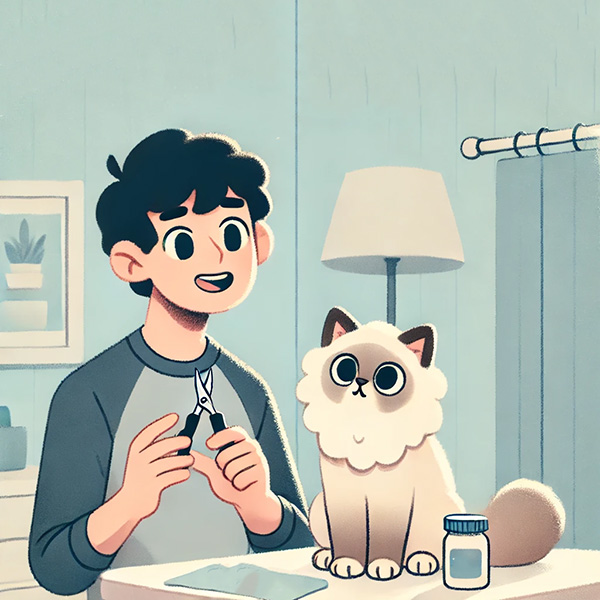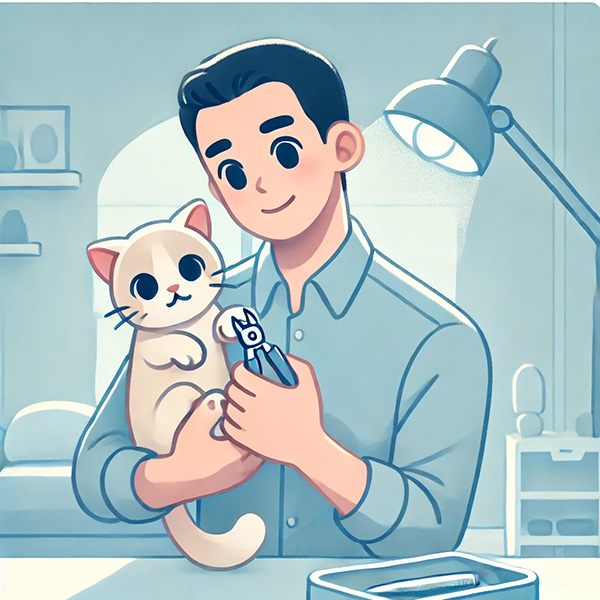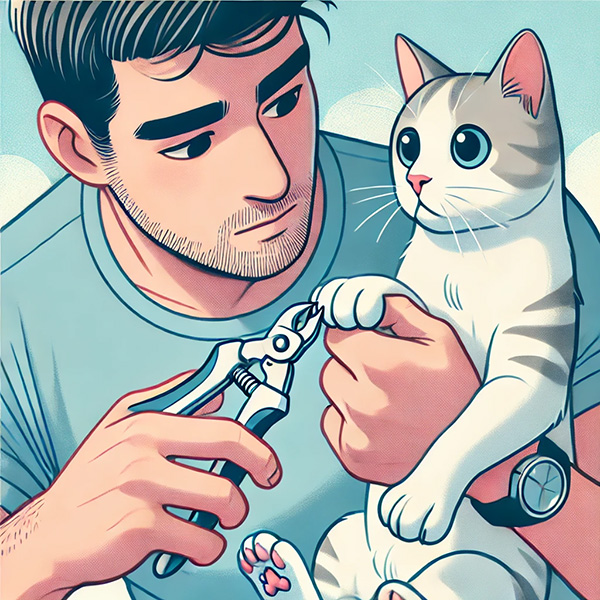Regularly trimming your cat's nails ensures their overall health and wellness. If left unchecked, long cat claws can cause discomfort, injury, and even infection. Regularly trimming cat nails also helps prevent damage to furniture and reduces the risk of accidental scratches. By following step-by-step tips on trimming cat nails, you can ensure your cat stays comfortable and healthy. It’s important to gently squeeze the paw to extend one paw at a time, carefully cut your cat's nails, and prevent issues that could affect other cats or pets.
How Often Should You Trim Your Cat’s Nails?
The need for nail trimming in your cat varies based on factors such as their age, level of activity, and living environment. Most cats that spend time outdoors or use a scratching post may naturally wear down their cat nails, requiring less frequent nail trims. However, indoor cats or those less active may need more regular cat nail clipping. Typically, you should trim your cat's nails every 2 to 4 weeks. Older cats may need more frequent attention as they might have trouble retracting their claws.
Tools You’ll Need for Nail Trimming
Pet Nail Clippers: Cat nail clippers generally fall into two primary categories: guillotine-style and scissor-type. You can also try nail grinders, but never use human nail clippers. Guillotine clippers feature a small opening for placing the nail, and when you squeeze the handle, a blade moves across to cut the nail. Scissor-style clippers look like small scissors and work similarly, providing good control. It's essential to use clippers made specifically for cats, as they are designed to be smaller and safer for their delicate nails. Clippers for dogs or humans may be too large or cause splintering.
Styptic Powder: Mishaps can occur, and there may be times when you accidentally cut too close to the quick (the blood vessel within the nail), resulting in bleeding. Styptic powder, a clotting agent, is essential to stop bleeding quickly. Just apply a small amount to the trimmed nail using a cotton swab or your fingertip. It's best to have this on hand before starting the trimming, as cutting quickly can be painful and stressful for your cat.
Towel or Blanket: Some cats may become squirmy or anxious during nail trims. Wrapping your cat gently in a towel or blanket can help soothe them and ensure they feel secure. This technique, often called a "kitty burrito," helps restrict movement while leaving only one paw out at a time for trimming. This helps to keep both you and your cat safe during the process.
Treats: To ensure a successful nail-trimming experience for your cat, positive reinforcement plays a crucial role. Providing treats before, during (if feasible), and after the nail trimming session helps your cat associate the process with positive outcomes. With time, your cat may become more willing to cooperate, anticipating the reward that follows. Choose treats your cat loves and give them calmly after each successful step.
Cat Nail File (Optional): After trimming the nails, you may notice sharp edges that can catch on fabrics or scratch your skin. Using a cat-specific nail file can delicately smooth the edges of your cat's nails. While this step is not mandatory, it can help minimize the risk of your cat unintentionally scratching furniture or people.
Step By Step To Trimming Cat's Nail
Preparing Your Cat Mentally for Nail Trims

Many cats are sensitive about having their paws and cat claws handled, making it essential to prepare them mentally before starting nail trimming. Begin by gently pressing and massaging their paw pads to get them used to the sensation. This approach can be beneficial during nail trimming sessions for your cat. Providing treats after each trimming session helps foster a positive association with the experience. This preparation will make cutting your cat’s nails smoother, as they’ll be more comfortable having their cat's feet handled.
Choosing the Right Time to Trim
Choose a time when your feline companion is calm and at ease, like after a meal or a play session. Cats are easier to handle when they are not overly energetic. This reduces stress and makes trimming cat nails less challenging for you and your pet. A peaceful, patient approach will ensure your cat’s nails get trimmed efficiently and hassle-free.
Creating a Calm Environment
Set up a quiet space with minimal distractions for the cat nail-clipping session. This environment will help keep your cat calm. You can also use calming aids like sprays, diffusers, or soft music to keep your cat’s claws relaxed during the nail trimming. Most cats respond well to a soothing environment, making it easier to focus on getting all their nails trimmed safely, avoiding any accidental hits to the quick.
Hold Your Cat Properly

To safely trim your cat’s nails, securely and gently hold your cat on your lap or a stable surface. Whether you rest your cat in your arms or place them on a table, ensure their paws are easy to access. If your cat tends to squirm, use your non-dominant hand to restrain them or ask someone for assistance gently. For particularly difficult cats, the towel wrap method, known as the "kitty burrito," can help keep one paw exposed while you trim kitty's nails.
The Kitty Burrito Method
The kitty burrito technique is effective for cats who resist having their cat claws trimmed. Wrap your cat snugly in a towel, exposing only one paw at a time. This minimizes movement, helping you safely cut your cat's nails. Ensure your nail clippers and paper towel are on hand for a smooth process.
Isolating the Nail to Avoid Mistakes
Before using your nail clippers, gently press on your cat’s paw pad to extend the claw. This will help expose the sharp point of the cat's claws. Be careful not to accidentally hit the blood vessels, especially with dark nails, where it can be difficult to see the very tip of the clear nails. Always aim to trim just the sharp point for the cat's healthy and comfortable experience. If unsure, consult your cat’s veterinarian for an in-person demonstration.
The quick is the sensitive pink area inside a cat's claws that contains blood vessels and nerves. When trimming your cat's nails, it's crucial to avoid cutting into this area, as it can lead to pain and bleeding. Instead, focus on trimming the clear nails, cutting only the very tip. If you accidentally hit the quick, be prepared with styptic powder or a paper towel to stop the bleeding.
While most cats only need their front claws trimmed regularly, some may also require attention to their rear claws. If your cat’s rear claws are overgrown, follow the same process.
Cutting at the Right Angle

For proper nail trimming, always cut at a 45-degree angle, trimming just the point of the nail. This technique helps prevent discomfort and reduces the risk of cutting into the sensitive quickly. Make sure to gently squeeze your cat's paws to extend the claws, allowing you to see the cat’s nails accurately and prevent mistakes. Most cats require regular trims to avoid long nails that could damage their feet or get caught on the scratching post.
What to Do If You Cut the Quick
Remaining calm is crucial if you accidentally cut into the quick while trimming your cat's nails. Use styptic powder to stop bleeding quickly, and gently press it to the affected area on your cat's nail. After applying the powder, comfort your furry friend by giving them a treat and reassuring them. This will assist both you and your cat in staying relaxed during the experience. This situation can happen to many cats, but with proper care, your cat's claws will heal quickly.
Rewarding Your Cat for Cooperation
After each nail trim, give your cat a treat they love as a reward. Positive reinforcement will help them associate nail trimming with a pleasant experience.
FAQs
What to Do If Your Cat Is Too Anxious
If your cat becomes too anxious or agitated while you're trying to trim cat nails, it's best to stop and try again later. Breaking the process into multiple short sessions can help, such as trimming one paw at a time instead of cutting all your cat's nails simultaneously. This reduces stress for you and your furry friend and lets your cat stay more relaxed during each session.
When to Seek Professional Help
If trimming a cat's nails becomes too difficult, or if you feel uncomfortable, it’s a good idea to seek help from a vet or professional groomer. Many cats are resistant to nail trimming, and professionals can use their expertise to safely trim a cat's nails without causing harm to their claws or cat's paws.
How Often Should You Trim Your Cat's Nails?
As a general guideline, inspect your cat's claws every few weeks. If their claws appear long or sharp, it’s time to trim cat nails. Indoor cats may require more frequent trims than other pets or outdoor cats. Regular trimming prevents discomfort, overgrowth, and the need for emergency use of styptic powder to stop bleeding from accidental cuts.
What Are Signs of Overgrown or Ingrown Nails
When cat nails become overgrown, they can curl into your cat's paws, leading to discomfort, pain, and even infection. This can make it essential to know how to trim cat nails regularly. Watch for signs like limping, excessive paw licking, or claws getting stuck on fabrics—these are clear indicators that it's time to trim a cat's nails. If you notice these signs, it’s crucial to trim my cat’s nails using proper step-by-step tips to avoid further injury. Ensure that styptic powder is nearby in case you accidentally trim the cat's nail too short. Keeping your furry friend's claws well-maintained will prevent painful overgrowth and keep both you and your cat comfortable.
